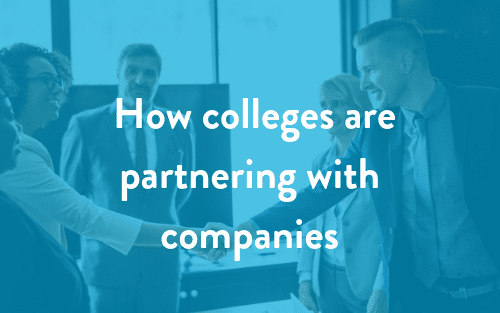According to a report by Bloomberg Next, only 35% of employers feel that new recruits are prepared with hard technical skills and “soft” skills like problem-solving. Both students and employers want curriculum to include actual skills that will be utilized in the workplace. And that doesn’t just mean technical skills. In fact, a Pearson study found that some of the most in-demand skills include complex problem-solving, decision making, and the ability to work in teams.
Colleges and universities have learned that ensuring students are “workforce ready”—aka having both hard and soft skills—means extending their education beyond the classroom. To do that, higher education institutions are partnering with companies from a wide range of industries to bring real-world experience to students.
By partnering with companies to ensure students are learning the latest skills in workplace, colleges and universities can continue to increase job placement rates. And on the other side, companies can benefit from a well-prepared talent pipeline.
Below, we outline 5 ways college and universities are partnering with companies in order to close the skill gap between college curriculum and the workplace.
- To create research opportunities.
Research programs are often costly, and colleges can struggle with constantly finding new ways to fund research opportunities for students and faculty. Thankfully, there are organizations out there like VentureWell who provide faculty grants and support for early-stage innovators.
John DesJardins, associate professor of bioengineering at Clemson University, was able to develop a program dedicated to connecting biomedical companies with biomedical engineering students to develop new medical innovations, thanks to the VentureWell faculty grant. The Developing World Biomedical Innovation Co-op program allowed students from Clemson to travel to Tanzania to assess medical needs in the area.
Partnerships like these are mutually beneficial—companies benefit from gaining insights into medical device needs in other countries while students benefit from developing real-world research and development experience.
- To develop a career-ready skills.
Career-ready skills continues to be a number one priority for colleges and universities. Higher education institutions need to ensure that their students are prepared for the workforce and able to successfully land a job after graduation.
Cal Poly, San Luis Obispo recently announced a partnership with Fullstack Academy, a coding bootcamp that offers immersive programs to teach students a variety of different frameworks and languages. Together, Cal Poly and Fullstack Academy will launch a 26-week part-time online program. Fullstack Academy will oversee course instruction while the class will be under the Cal Poly brand and allow students to earn a certificate from Cal Poly’s Extended Education school.
Coding bootcamps have become extremely popular over the past few years, especially among students aged 25+. By utilizing Fullstack’s infrastructure, Cal Poly is able to make their course offerings more accessible to part-time students.
- To provide access to industry resources.
It can be difficult for students to get industry experience when their specialty requires expensive equipment. To break down that barrier, SSC Labs, a company that specializes in electromagnetic interference, opened a research facility on the campus of University of Nevada, Reno. By placing itself on the university’s campus, SSC Labs is able to make use of the College of Engineering’s existing laboratory equipment as well as make its own equipment available to students for learning opportunities.
- To allow students to develop industry-specific skills.
It can be difficult for students to gain real-world experience in a classroom setting. Colleges attempt to provide opportunities through case studies and hypothetical projects, but the best way to gain real-world experience is by utilizing the actual tools companies use.
Facebook recently found that a large amount of small business owners are lacking employees that have digital marketing skills. To solve for this, Facebook is partnering with colleges like Des Moines Area Community College and Central New Mexico Community College to teach students the skills they need to excel in digital marketing.
- To offer an apprenticeship.
One of the best ways to guarantee students a job after graduation is through company-specific training. By allowing students to learn the exact skills a company is looking for, colleges can continue to increase their job placement rate.
In 2012, Central Piedmont Community College launched “Apprenticeship Charlotte”, a career-training program that offers students the opportunity to receive intensive, company-specific training while earning college credit. This allows the college to help place students in jobs and gives participating companies a healthy pipeline of talent. The program currently works with eight different companies and offer 98 apprentices works for employers like Siemens and Cummins.
Now that you’ve seen some great examples of how higher education institutions can partner with companies—how can you make it happen for your institution?
To start, you should have an area on your website that showcases different partnership opportunities you’re interested in and allows companies to get in touch with you. University of Michigan does a great job of showcasing the three main ways to partner with the institution: research/technology, new programs or certifications, and recruiting. In order for any partnership to succeed, both parties involved need to benefit. For example, if a college is partnering on a new program with a company, the college would benefit from the resources and infrastructure of the company while the company would benefit from the brand recognition and gaining new users (aka students).
When looking for a partnership opportunities, decide what types of initiatives are most important for your institution first. For example, if you are looking to increase job placement rates, a specialized course or apprenticeship opportunities may be what you’re hoping to find in a partnership. If you’re looking to expand students’ access to resources and technology, a research grant may be the best option.
Partnering with corporations can help grow your institution, improve the quality of curriculum, increase resources to students, and allow students to acquire both hard and soft skills that are highly sought after in the corporate world.






